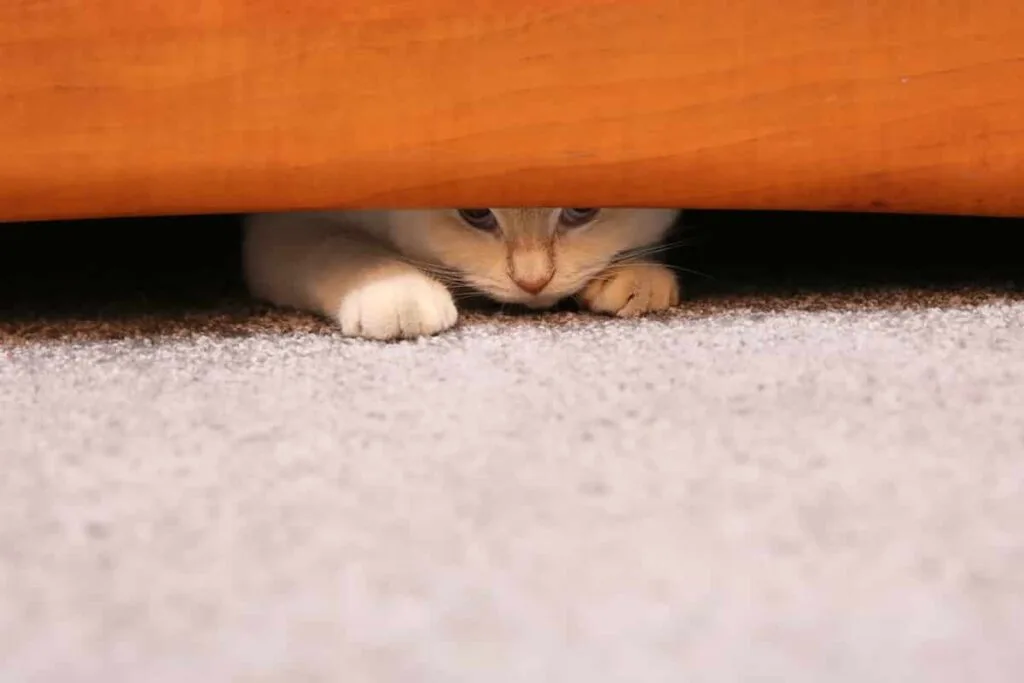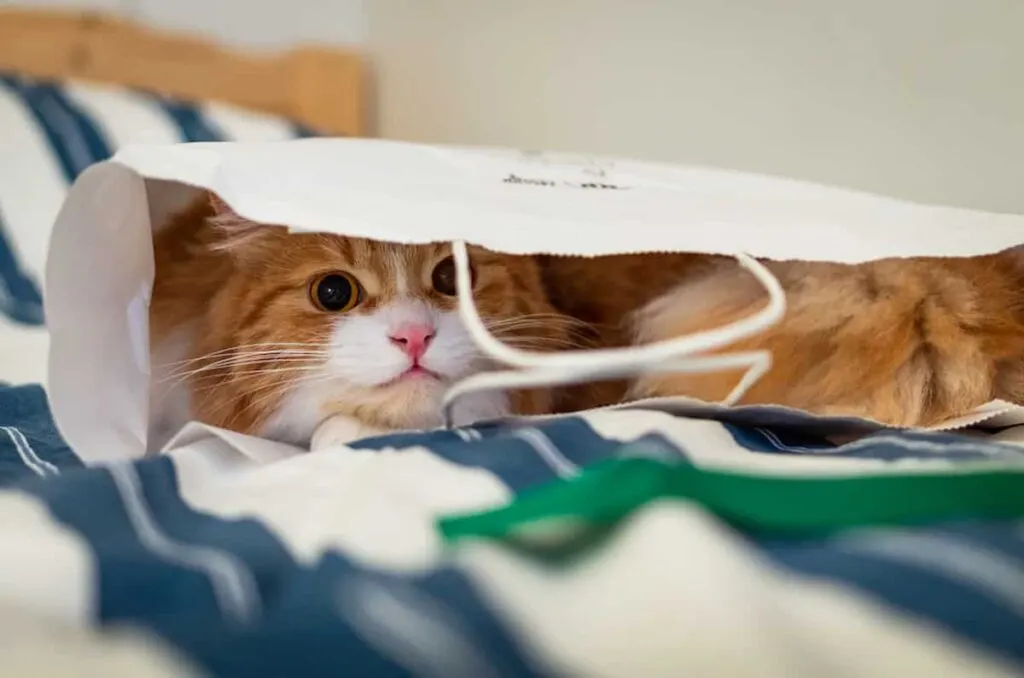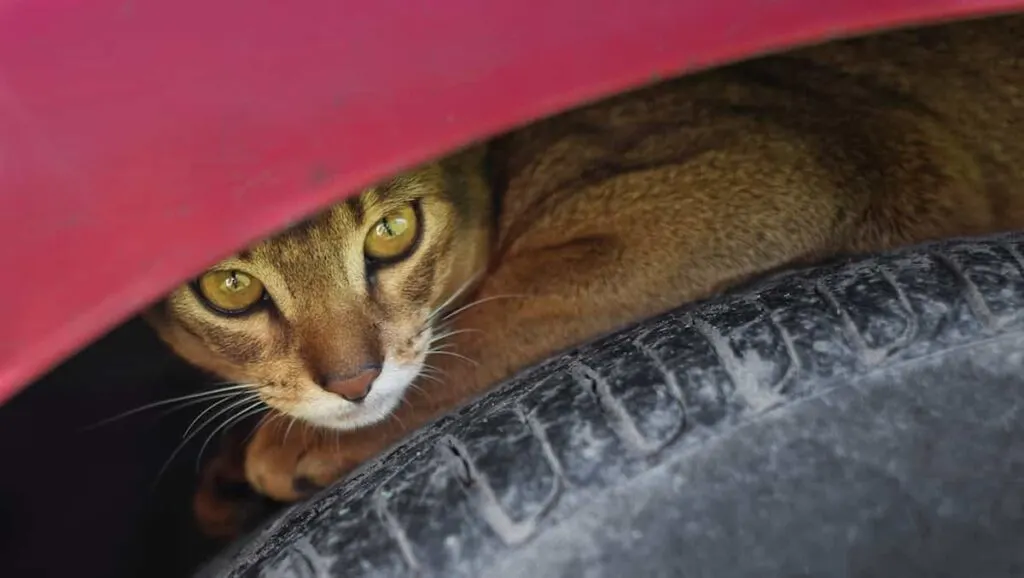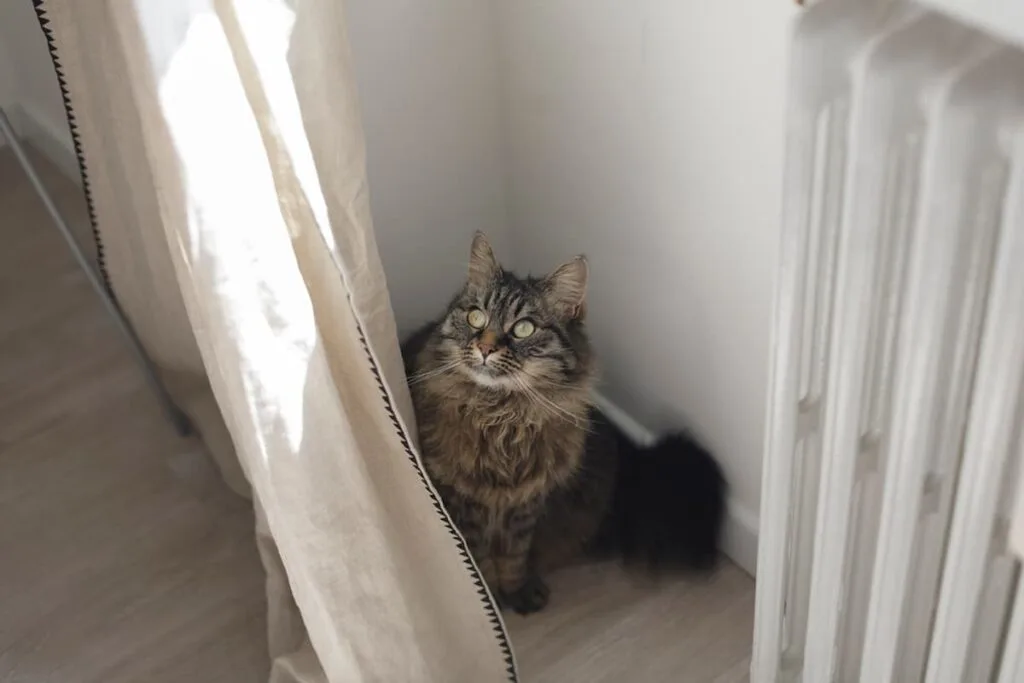Cats are fascinating creatures that have been domesticated for thousands of years. They are known for their playful nature, and it’s not uncommon to see them running around the house, chasing toys, and pouncing on anything that moves.
However, one peculiar behavior I’ve experienced with my own cat is him hiding while we play certain games with him.
Contrary to popular belief, cats don’t necessarily hide in fear or shyness when they play. Rather, their actions are largely determined by a sophisticated set of animalistic instincts that encourage them to conceal while playing.
The explanation lies in their untamed origins. Domestic cats are the descendants of wild cats, and much of their original instincts remain. In nature, cats had to hunt for sustenance, often waiting patiently until prey wandered into view before pouncing on them.
Domestic cats exhibit this behavior inherited from their feral relatives, who would conceal themselves and wait for potential prey to pass by. This is why they prefer hiding while playing – it’s instinctive!

Instinctual Behavior
Even though cats are domesticated creatures, their instinct to hunt remains strong. When they play, it’s more than just a fun pastime; cats are honing their innate hunting skills of hiding and pouncing on prey! This explains why your beloved feline companion loves those laser pointers so much – they give them an opportunity to practice the hunter in them.
Lurking in the shadows and awaiting their opportunity to strike, cats are notorious for pouncing on whatever they can find – be it a stuffed animal or another feline companion.
Felines may hide while they are playing as a form of self-preservation, even if said cats live in the safety of their own home. Hiding behavior is due to instincts that tell them when there might be a potential danger and how important it is to stay hidden from view.
Crouching allows felines to monitor their environment without being spotted by any predators lurking nearby, giving them an extra sense of security.
Hiding behavior as a form of play
Hiding isn’t solely a survival skill for cats, but it also serves as an entertaining pastime. Cats love to play hide-and-seek with their owners or other felines!
Most cats take pleasure in the elation of pursuit and capture, offering them a sense of accomplishment. Also, with hiding, cats are able to flaunt their flexibility and strength as they sprint around and surprise their prey.

Comfort and Relaxation
Cats seek out secret hiding spots when they play because it allows them to feel safe and content. Cats love having a place of solace where they can truly relax, whether it’s boxes, sacks, or beneath furniture.
These cozy sanctuaries make for the ideal spots for cats to curl up and take a nap or just unwind.
Safety and Security
One of the primary reasons cats hide when they play is because they feel safer and more secure when hidden from view. This instinctual behavior is rooted in their wild ancestors who needed to stay hidden from predators in order to survive.
Although domestic cats aren’t subject to the same extent of peril, this habit is still ingrained in their genetic makeup.
Playing in the Wild
Some cats may toy with their prey before delivering the killing blow, while others prefer a more efficient approach. By honing these hunting skills, felines are able to hone their ability to successfully capture any prey they encounter.
Playing at Home
When cats play, they may feel like they are hunting, and their instinct to hide and stay safe kicks in. This happens at home all the time, especially when play is involved.
Whether it’s tossing around a toy mouse, or running around, if they see an opportunity to hone their skills, they will. Cats find hiding entertaining just as much as a survival skill. Although, sometimes cats like ours for example, can’t tell the difference between the two.
In addition to playing, if your kitty is socializing with other cats or humans, they may feel the need to safeguard themselves from any potential dangers.

Environmental Factors
Several environmental factors may cause cats to hide when they play. These factors include:
Noise
Cats are known to have sensitive ears, making loud noises startling and even scary for them. So if there’s construction or a thunderstorm brewing outside, they may stay hidden while playing to feel secure in their environment.
Space
All cats need plenty of room to move, explore and play. If their living quarters are too cramped or contain a lot of stuff, they can sense the constriction, which could make them feel uncomfortable.
To deal with this lack of space and adjust accordingly, cats may choose to hide when playing to have more freedom and privacy.
Other Pets
Other pets in the environment, such as dogs or cats, may intimidate or bully the cat. This can cause the cat to hide when they play to avoid confrontation and protect themselves.
We personally don’t let our cat engage with other pets just to keep things comfortable for him and so that he doesn’t associate future playtime with us as a negative experience based on what he remembers.
Past Trauma
If your feline friend has been mistreated or neglected, they may instinctively hide when it’s time for playtime. This can be due to a traumatic association between playtime and painful memories that make them anxious or scared.
Understanding these environmental factors can help cat owners create a safe and comfortable environment for their pets to play and thrive in.

Play as a Hunting Simulation
Cats love to hide and play, something they do in order to simulate a hunting experience. As natural predators, cats have an ingrained need to hunt – so while they are playing, their honing the skills necessary for survival. It is part of being hardwired into their DNA!
During play, cats hone their instinct to stalk and attack. Hiding behind furniture or burrowing underneath blankets helps them simulate the experience of chasing down prey. At the same time, they practice their killing bite when pouncing on a toy or another feline companion.
Instinctive Behavior
Felines are proficient and stealthy hunters, relying on their dexterity and agility to pursue prey. When they playfully engage in activities such as stalking or chasing objects, cats fulfill their inherent drive to hunt – even those who have never been exposed outdoors possess the same innate abilities as wild felines.
Playtime is an indispensable way to help cats release their built-up energy and reduce stress. Hunting is a very enthusiastic activity, so cats can become easily frustrated or bored if they do not have an appropriate place to put that energy into action.
Playing is key for developing their mental and physical capacity, which is essential for a healthy life.

Locations Where Your Cat May Hide During Playtime
Although all cats are different, there are a few common locations where cats tend to hide at during playtime.
Under the Bed
It’s not uncommon to find your cat hiding under the bed, it’s one of the most popular spots and easiest to access! So naturally, cats prefer it. Cats love to crawl into tight spaces, and the space under your bed provides just the right amount of seclusion for them to feel safe and secure.
Behind the Couch
Another common hiding spot for cats is behind the couch. This is because the couch provides a dark and cozy spot where they can curl up and take a nap without being disturbed. Keep the couch pushed up against the wall to prevent this.
Inside Boxes and Containers
Cats love boxes, and they’ll often climb inside them to hide. Cardboard boxes and even plastic containers are useful if its big enough to house your cat. Boxes provide cats with a sense of security and allow them to observe their surroundings from a safe distance.
Inside Closets
If you leave your closet door open, chances are your cat will climb inside and make themselves at home. Closets provide cats with a private space where they can retreat and feel safe.
Inside Cabinets
Cats are experts at squeezing themselves into tight spaces, and cabinets provide the perfect hiding spot. Just make sure to check before you close the door!

Behind Curtains
Cats love to climb and jump, and the space behind curtains gives them the perfect spot. Plus, the fabric of the curtains makes for a cozy hiding spot. Thin curtains are more common places for cats to hide because they still want to see what’s going on while being shielded. Shaded curtains or blackout curtains are less desirable for cats.
Under Furniture
Although cats prefer beds, sofas, chairs, and other pieces of furniture provide cats with a perfect spot to hide. This is especially true if the furniture is pushed against a wall or in a corner. One tip I can share is in regard to my own cat Harley. He loves hiding under our motorized reclining couch.
To help stop that, we keep it upright anytime he’s out in the main house; otherwise, he gravitates straight to it to hide.
In Plants
Cats love to be around plants and often climb inside pots and containers to hide. Just ensure the plant is safe for your cat before you let them explore. Avoid having plants with spiky ends or anything that secrets any liquids that could harm your cat’s skin.
Final Thoughts
Cats may be famed for their fun-loving attitude, yet beneath this joyous exterior lies an instinct to conceal themselves when playing. This behavior is inherited from the wild cats of yore, who had to protect themselves from being predated upon while searching for food.
Having experienced this with our own cat hiding from us many times, the experience they have when you play with them must be a positive one. The more positive you can make the activities your cat does, the more likely they will be present and not look at it as a fearful experience.
If your cat suddenly starts hiding during playtime, then there could be more going on than you realize.
Cat owners must understand this behavior and provide their feline friends with safe and secure places to play and hide. This can be achieved by providing them with toys, scratching posts, and hiding spots in the home.

My name is James, and welcome to FAQCats!
Along with our team of cat owners, expert pet enthusiasts, and pet professionals, we aim to write engaging helpful, engaging content about cats. At FAQCats we strive to provide content that’s accurate and fun to read. Our team writes about everything related to cats; even the most complex of topics. Through extensive research and caring for our own fur-pals, we’re able to provide something cat owners worldwide will love. Have a look around, and leave us feedback anytime!

